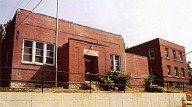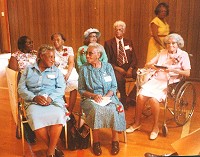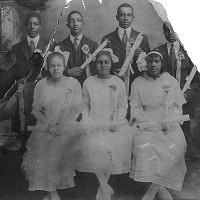Garrison School HistoryThis video was produced by Liberty North Students Emma Reiser, Bailey Redford, Madison Gabbert, Grace Livia, and Caroline Utz. Prior to 1865 it was against the law to teach a slave to read or write, and for more than a century Liberty African Americans lived, as other blacks in America, under the law of “separate but equal education.” When the Civil War ended, African Americans first attended a private school located on West Mill for black and Indian children in the home of Mrs. Laura Armstrong, a liberal white. Later during this period, Mrs. Lucretia Robinson opened her home on North Water Street for the private tutoring of blacks. The third school was located in the Old Rock Church from 1875-79 which stood on the hill near the present site of Garrison.
The first Garrison School building stood until 1910. At the time, the Liberty Advance announced that “the public school building for the Negro children of the Liberty district burned.” In the meantime, the Liberty school board president, S.G. Sandusky, noted that a new building would cost $5,000 versus a $2,500 insurance policy. After agreeing to rebuild, the board then rented a room in the Negro Lodge Hall for the children until the new building could be completed. In 1911 the community opened a new black school. The principal, Professor James A. Gay, decided the school should keep the name Garrison in honor of William Lloyd Garrison, an abolitionist who served in President Abraham Lincoln’s cabinet. Garrison School soon earned the reputation as being the best school for African American students in the state of Missouri. Another distinguished principal and educator of Garrison School was Clarence E. Gantt. Under his leadership and administration a new gymnasium was built in 1938. Until this time, African American students had neither assembly room facilities, gymnasium, nor current textbooks. The students used obsolete texts that were castoffs from the white schools. Mr.Gantt challenged the inequities in the education of black students at Garrison, and through his efforts, the white community responded by passing a favorable school bond issue on September 27, 1938, to add a new addition, Garrison Assembly Room.
Garrison School, however, only provided its students with a 10th grade education, and the “separate but equal” laws barred them from attending Liberty’s white high school. Therefore, many Garrison graduates had to ride buses into Kansas City to attend the all black Lincoln High School. Finally, on May 17, 1954, as a result of arguments in the Supreme Court case Brown vs. the Topeka Board of Education, the court ruled “separate but equal education” unconstitutional, and the Liberty School District began to integrate its African American students. Garrison School has served the community throughout the years: an office for the Liberty Parks and Recreation Department; Ozanam School for special needs youth; a coffee house; the Liberty School District Kindergarten; and, a school for Liberty Celebration Christian Academy.
To Make a Donation Contact: |
 |


 African American residents established Garrison School in 1877. The first principal was Professor J. W. Mozee followed by John L. Talton, Virgil Williams, James A. Gay and C. E. Gantt. The first three graduates of Garrison were Maggie Bright, Nathan Bright and William Robinson in 1893, and Cora Granberry and Hattie Ashcraft were the teachers.
African American residents established Garrison School in 1877. The first principal was Professor J. W. Mozee followed by John L. Talton, Virgil Williams, James A. Gay and C. E. Gantt. The first three graduates of Garrison were Maggie Bright, Nathan Bright and William Robinson in 1893, and Cora Granberry and Hattie Ashcraft were the teachers. 

 In December of 2003, the members of the Clay County African American Legacy Consortium incorporated. The CCAAL Inc. Board purchased Garrison School from the Liberty School District and assumed ownership of the historic educational institution. Currently it serves as office space for the Clay County African American Legacy Inc. and as a Recreational Center for cultural and educational events. Garrison School is listed on both the National and Local Register of Historic Places in Clay County.
In December of 2003, the members of the Clay County African American Legacy Consortium incorporated. The CCAAL Inc. Board purchased Garrison School from the Liberty School District and assumed ownership of the historic educational institution. Currently it serves as office space for the Clay County African American Legacy Inc. and as a Recreational Center for cultural and educational events. Garrison School is listed on both the National and Local Register of Historic Places in Clay County. The Clay County African American Legacy Inc. is committed to educating and informing the community of the accomplishments of African Americans of Clay County and how they have influenced and contributed to the rich history of the Northland. Garrison School provides a place for the CCAAL Inc. to host community events, exhibits, cultural and educational programs, recreational opportunities and to establish partnerships with not for profit organizations.
The Clay County African American Legacy Inc. is committed to educating and informing the community of the accomplishments of African Americans of Clay County and how they have influenced and contributed to the rich history of the Northland. Garrison School provides a place for the CCAAL Inc. to host community events, exhibits, cultural and educational programs, recreational opportunities and to establish partnerships with not for profit organizations. 
